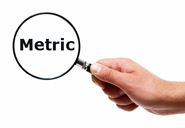We asked our reader panel for their advice on getting the best out of your contact centre metrics.
1. Focus on what is driving results rather than the result itself
Create a monthly scorecard and ensure that the way you measure each metric is clear, accurate and fair to all agents.
In addition, when supervisors coach about the results of the scorecard, they need to coach about what is driving it rather than the result itself. This will help everyone to see what (and how) improvements can be made.
With thanks to Annette
2. Use ‘NetEasy’ to directly improve the customer journey
We use the NetEasy score as our main service metric. This is because the insight it gives us allows us to take action to directly improve service on specific points in the customer journey.
We also use NetPromoter Score (NPS), right first time, one-contact resolution, financial measures and advisor satisfaction.
With thanks to Fiona
3. Reinforce the importance of metrics in all aspects of the contact centre
You need to make it clear to your agents what their individual contribution is to the overall objective of your contact centre. This then needs to be reinforced in all aspects of the contact centre.
For example, if you are measuring FCR then include this in all material relating to your coaching and objectives so that the agents don’t lose sight of it.
With thanks to Sarah
4. Pitch teams against one another to improve overall performance

We pitch teams against one another to improve overall performance.
This motivates our team leaders to focus on their team’s performance, as they are rewarded for being top of the ‘Leader Board’.
With thanks to Lisa
5. Link metrics directly to a salary framework
We measure Productivity, SLA, Talk Time and Quality. These are then linked directly to a salary framework.
The better the agents perform, the higher salary they can achieve.
With thanks to Michelle
6. Use 2 questions to monitor Customer Effort
We ask the customer “how easy was it to get what you wanted?” as well as “how easy was the interaction with the advisor?”
This gives us two ways of capturing Customer Effort.
With thanks to Fiona
7. Try not to look at any one metric in isolation

Try not to look at any one metric in isolation. For an outbound function we would look at revenue, conversion, calls per hour and talk time. This works well.
With thanks to Julie
8. Use Agent Available Time instead of Average Handling Time
We use Agent Available Time instead of Average Handling Time so that agents feel free to take the time they need with the customer, but also understand that they need to be there to answer the calls.
With thanks to Kris
9. Swap metrics in and out depending on the business strategy
Our monthly CSR scorecards contain the following metrics: Quality, Adherence and Average Order Value (as main KPIs) and Hold Time, Wrap Time, AOV, Talk Time %, conversion, revenue per call and not ready time (as secondary measures).
In addition, our framework allows us to swap metrics in and out dependent on the business strategy.
With thanks to Paul
10. Set an upper and lower boundary for AHT
Average Handling Time is a useful metric for budgeting purposes.
If using this as a target at agent level, set an upper and lower boundary for them to aim between. That way you’re not speeding up slower people or slowing down faster people.
Most importantly, you should match it to the quality score and never treat it in isolation.
With thanks to Paul
11. Concentrate on the things that have a direct impact on your customer base

When focusing on metrics, don’t forget to concentrate on the things that have a direct impact on your customer base.
No matter what the business, it is always cheaper to retain your customers than it is to attract new ones.
With thanks to David
12. AHT should not be a made a focus
AHT is a metric that needs to be measured and kept in check at the management level. But it should not be made a focus, as it could drive the wrong behaviour in agents.
Stay in tune with it, understand what is driving it up and down, and coach to the outliers you have in your contact centre. Keep in mind it being too high or too low can be a red flag.
With thanks to Annette
13. Make the customer scores visible on the account profile of your CRM
Make the customer scores visible on the account profile of your CRM.
This way the agent will see whether the customer on the phone is an ambassador (or not) of your company or product and can take this into account in how to approach the customer.
With thanks to Dennis
14. Measure quality to avoid driving the wrong behaviour

Ranking agents against a ratio of cost vs return will drive profitability, while measuring quality will avoid driving the wrong behaviour.
With thanks to Matthew
15. Train your teams to recognise different personality types
Train the teams on the 4 different personality types and the best ways to interact with each. That way they can tailor each call to the needs of the individual.
With thanks to Eileen
16. Measure effort by channel
Measure effort by channel and against the advisors themselves.
With thanks to Fiona
17. Involve your agents in reviewing and setting up your metrics
Involve your agents in reviewing and setting up your metrics.
It really helps you to achieve buy-in.
With thanks to Anthony
18. Link effort directly to churn

Take a look at your Customer Effort scores and see how well they correlate with customer churn.
With thanks to Fiona
19. We have a dashboard that agents can review from their PC at any time
We have a dashboard that agents can review from their PC at any time. This measures Quality, Productivity, SLA and Talk Time.
These measures are then weighted to give an overall score for the agent, and are directly linked to a salary framework. Therefore, the higher they achieve in the KPIs, the higher salary they can achieve.
With thanks to Michelle
20. Any metric used should be linked to the overall business strategy
Any metric used should be linked to the overall business strategy and support the next level objective.
Agents should also be trained to have full understanding as to how their work enables the delivery of business objectives.
With thanks to Robet
21. Set targets in categories of Great, Good and Needs Improvement

Our metrics align with appraisals, and we set the targets into categories of Great, Good and Needs Improvement.
This ensures the agents know what is required of them at the start of their appraisal year. We track this month on month to ensure they are on track.
With thanks to Mark
22. Introduce a bonus to help agents focus on what is important
If you find that your agents don’t seem to care about the quality of their calls (or any other metric) try attaching it to a bonus.
We have just done that and it has really helped to change the agents’ focus.
With thanks to Sue
23. Make changes to your overall business processes to reduce AHT
AHT is a valuable metric. But the goal should be to amend business processes to reduce the propensity for customers to need to talk to us about the issues that drive a higher AHT.
With thanks to Keith
24. Don’t forget to measure advisor satisfaction too
Don’t forget to measure advisor satisfaction too.
With thanks to Fiona
How do you make your metrics work harder?
Author: Megan Jones
Published On: 23rd Apr 2014 - Last modified: 31st May 2017
Read more about - Hints and Tips, Metrics, NetEasy, Scorecard, Service Level
















